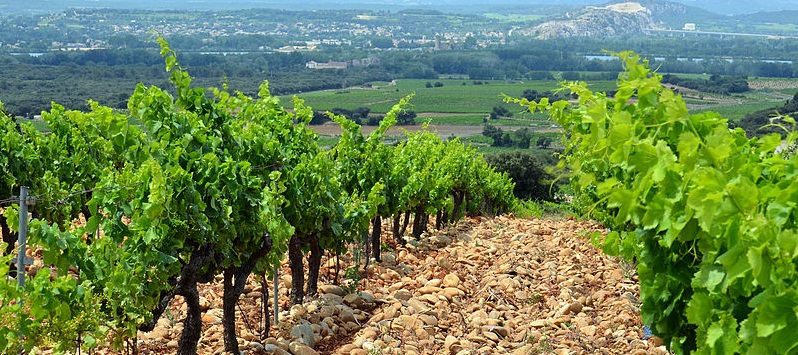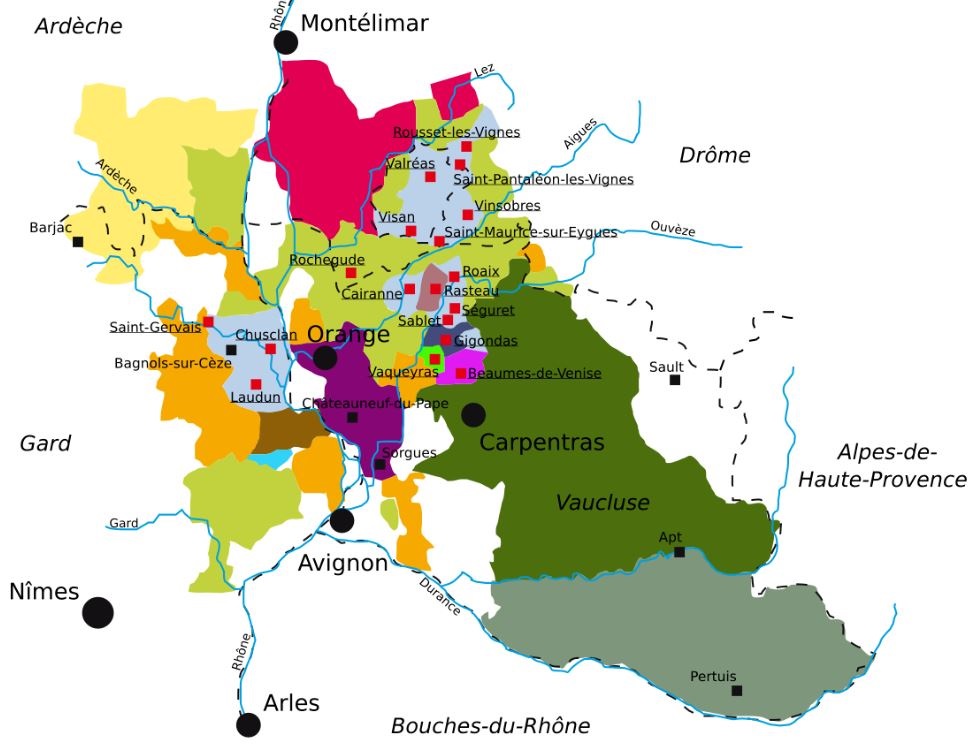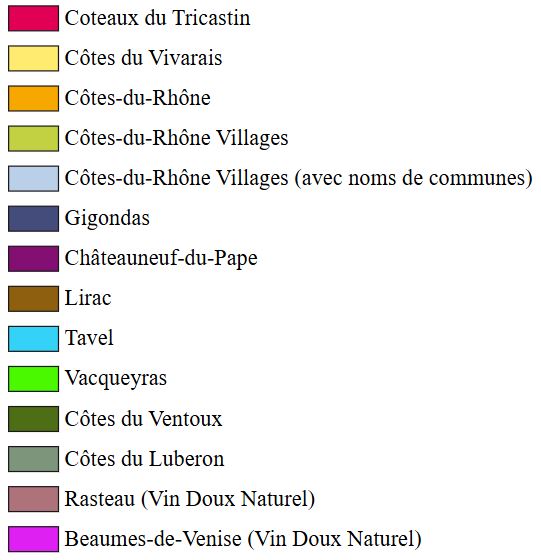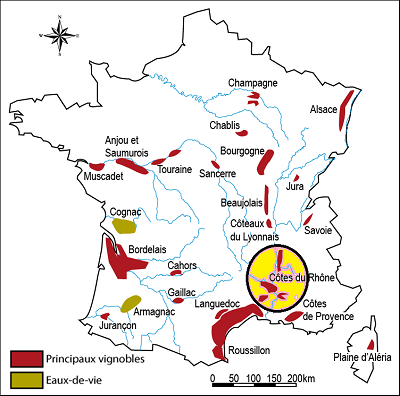Côte du Rhône (Rhône Valley)
Côte du Rhône is a key wine region in the south of France.
The region stretches from Lyon in the north to Avignon in the south, encompassing a variety of climates, soils, and grape varieties. This diversity results in a wide array of wine styles, from robust reds and aromatic whites to luscious rosés.
The Rhône Valley is traditionally divided into two parts: the Northern Rhône and the Southern Rhône, each with its unique characteristics and appellations.
Côtes du Rhône AOC
Côtes du Rhône AOC (Appellation d'Origine Contrôlée) is a wine region in the Rhône region of France.
There are two main Côtes du Rhône regions:
- Côtes du Rhône South (Méridional).
- Côtes du Rhône North (Septentrional).
Côtes du Rhône South
The Southern Rhône features a warmer Mediterranean climate and a wide variety of soil types.
The main grape in the south is Grenache.
The region is also famous for its GSM wines: A blend of Grenache, Syrah, and Mourvèdre.
The area also produces whites, rosés, and even some sweet wines.
The climate is Mediterranean – dry with plenty of sunshine – and heavily influenced by the Mistral wind, which gusts through the vineyards, helping the grapes to stay healthy all year round.
Châteauneuf-du-Pape (AOC in 1936)
Châteauneuf-du-Pape is the most famous appellation in the Côtes du Rhône South. It was the first AOC to be recognized when the system was instituted in 1936
The region is known for its powerful and complex red blends, which can include up to 18 different grape varieties.

Châteauneuf-du-Pape's large, heat-retaining galets (pebbles) are a defining feature of its vineyards.
Côtes du Rhône (AOC in 1937)
Côtes du Rhônes is the basic AOC of the Rhône region.
It produces half of the total wine production in the valley.
Most of the AOC produces red wine, but there rosé and white wines too.
Côtes du Rhône Villages (AOC in 1966)
Côtes-du-Rhône Villages is an AOC in Côtes-du-Rhône South.
The quality is higher than the generic Côtes-du-Rhône AOC, but below more specific appellations such as Châteauneuf-du-Pape AOC and Vacqueyras AOC.
All Côtes du Rhône Villages have the option to apply for an AOC status.
Gigondas (AOC in 1971)
Similar to Châteauneuf-du-Pape, Gigondas produces robust red wines with a slightly more approachable price point.
Red and black cherries and red and blue berries are typical Gigondas flavors, with hints of pepper and licorice.
The climate is hot and dry with 2,800 hours of sun a year, but heavy influenced by the Mistral wind.
Vacqueyras (AOC in 1990)
The wines of Vacqueyras come in red, white and rosé. They are known to be powerful and full of character with a distinctive edge of freshness and finesse.
Tavel (AOC in 1936)
Tavel AOC produces only rosé wines, known for their aromatic full-body, complex structure, and ability to age. It is a wine for gourmets, one of those wines that can accompany you from the starter to the dessert.
Grenache and Cinsault are the main grapes, along with Syrah and Mourvedre (permitted from 1969).
The climate is Mediterranean, with low rainfall and 2,700 hours of sunshine a year, but heavily influenced by the Mistral wind.
Lirac (AOC in 1947)
Red Lirac often resembles Côtes du Rhône-Villages wines. Lirac Rosé is similar to Tavel Rosé.
The climate is Mediterranean, with low rainfall and 2,700 hours of sunshine a year.
Costières de Nîmes (AOC in 1989)
Costières-de-Nîmes is located in the extreme southwest of the Rhône valley The AOC mainly produces red GSM wines and rosé wines.
Beaumes-de-Venise (AOC in 2005)
Beaumes de Venise is located at the foothills of the Dentelles de Montmirail, has a terroir Triassic soil, ideal for producing Grenache, white limestone and grey marls.
Varieties permitted in the red GSM are Grenache 50%, Syrah 25%, Mourvèdre and others (25%).
Muscat Beaumes-de-Venise is a fortified wine with a worldwide reputation, made exclusively from Muscat à Petits Grains.
The climate is influenced by the Mediterranean. Temperatures are warm, The Dentelles de Montmirail protect the area from the cold northern Mistral wind.
Vinsobres (AOC in 2006)
The soil in Vinsobres is very stony, and their warmth allows the vines to ripen early.
From Grenache and Syrah, Vinsobres produce dark red wines with complex and spiced flavours.
A particular microclimate protects Vinsobres' vines planted in amphitheatre formation. Summers are hot and dry, with the Mistral wind and Pontias wind bringing cooler air at night.
Rastau (AOC in 2010)
Rastau produces dry red wines with a very distinctive character.
Rasteau is also known for its Vin Doux Naturel fortified wines.
The Climate is Mediterranean. South-facing slopes give some protection from the Mistral wind.
Cairanne (AOC in 2016)
Cairanne is a gateway to the northern Rhône, combining the Syrah grape with the more southern Grenache and Mourvèdre.
The Climate is Mediterranean. Dry with plenty of sun and heavily influenced by the Mistral wind.
Côtes du Rhône South
In Côtes du Rhône South, the main grape is Grenache.
The area is most famous for its GSM wines: A blend of Grenache, Syrah, and Mourvèdre.
Red Wines:
GSM Wines
Côtes du Rhône South
Châteauneuf-du-Pape
Grenache
Syrah
Mourvèdre
Counoise
White Wines:
Châteauneuf-du-Pape
Grenache Blanche


